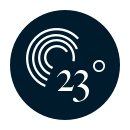23° offers a wide range of different ways to visualize data. We summarized the most important ones in this blogpost.
## Hier klicken um zur deutschen Version zu kommen ##
1. Maps
1.1
Choropleth Maps
Choropleth maps display geographic entities according to values or categories. They can show demographic declines, high rental fees or unemployment rates. They can also be coloured according to categories. For example: EU members, strongest party in an election etc.
The displayed areas can be: States, federal states, municipalities, constituencies or other statistical or administrative levels. Here is a list of all administrative levels available at 23 °.
1.2
3D-Maps (Extrude Maps)
In addition to the regular choropleth maps, you can also create extrude maps on 23 °. Here the choropleths are shown as a 3D animation. The height of the choropleths shows the ratio value.
1.3
Bubble Maps
Bubble maps are similar to choropleth maps in the way that they represent values or categories assigned to a specific geography. They have the advantage that even small areas, e.g. island states, are clearly visible on the map. In addition, as with the extrude map, the radius of the bubbles allows an extra dimension of information to be shown.
1.4
Pin Maps (Marker Maps)
Marker maps are maps with markers/pins assigned to specific coordinates. They will be made available to all users at 23° in the next few weeks, as they are currently still in the beta phase. All our users can then create interactive maps with customizable pins, markers, text and image annotations. There’s also the option of a JSON upload to quickly and easily display large amounts of data on the map.
Pin maps are very suitable for displaying locations and events. The map below shows, for example, the locations at which companies are doing research to find a cure for Covid-19.
2. Bar Charts
2.1
Bar Charts
Bar charts are often the easiest and most efficient way to tell a data story.
In addition to the clear depiction, which make bar charts so easy to understand, they are usually also extremely easy and quick to create.
All you need to create a simple bar chart is a data table that includes at least one text and value column.
2.2
Grouped Bar Charts
Grouped bar charts are similar to simple bar charts, yet they allow the user to show even more data. The grouped bar charts makes it possible to add a third dimension to the two previous dimensions of text and value. This dimension forms the group according to which a grouped or a stacked bar chart is sorted.
2.3
Stacked Bar Charts
A stacked bar chart differs from a grouped bar chart in that it makes it easier to display and read the cumulative value.
All bar charts can be displayed horizontally or vertically.
2.4
Area Charts
An area chart is basically a stacked bar chart in which the X-Axis acts as a time dimension.
3. Line Charts
3.1
Line Charts
These charts usually display the development or change of one or more variables over time.
4. Donut Charts
4.1
Donut Chart
A donut chart makes it possible to display partial values of a whole as parts of a circle. The individual components of a donut chart can represent both absolute and relative values.
4.2
Half-Donut
With the Half-Donut the same rules apply as for a regular donut chart or pie chart. Half-donuts are often used to represent the distribution of seats in a parliament.
Follow us
web: app.23degrees.io
mail: office@23degrees.io
twitter: @23degrees_io
fb: @23degrees.io
ig: @23degrees_io
